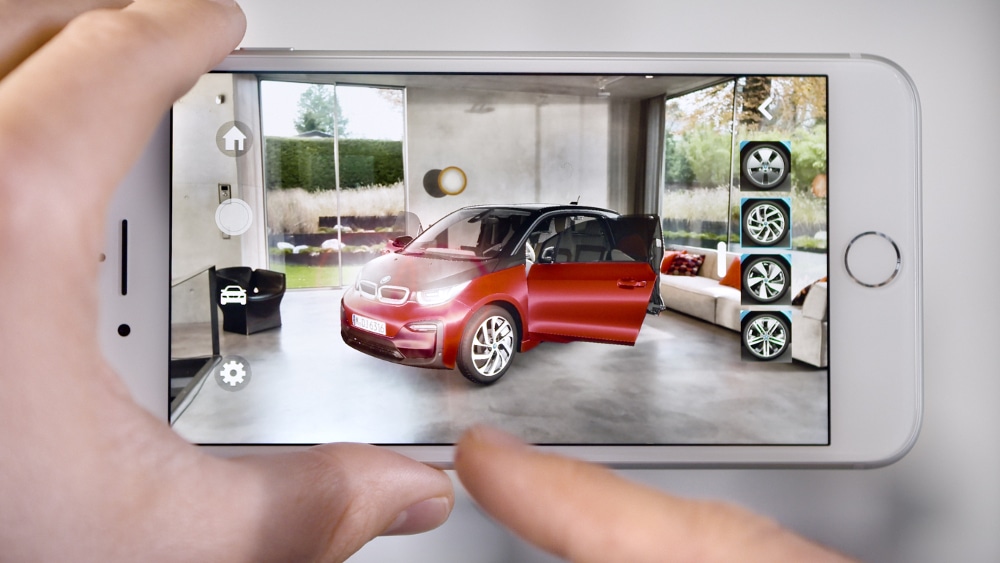
As XR grows among consumers and enterprises, support functions will grow with it — just like we saw in the smartphone revolution. And a key part of that ecosystem is enterprise consulting. That’s where Accenture Extended Reality plays.
A division of global professional services firm Accenture, the Extended Reality team focuses on XR (AR/VR/MR) for enterprises. It applies a proven process that includes making sure clients’ XR deployments are scalable, not just a one-time thing. And that requires setting goals clearly.
“Instead of wanting to just do something in AR or VR, figure out the story you’re trying to tell and determine if it fits AR or VR?” Accenture XR’s Go-to Market Lead Raffaella Camera told ARtillry. “If VR is the answer, does it fit a computer graphics based experience or a 360 experience?”
One of Accenture XR’s recent projects for example was to plan and deploy BMW’s iVisualizer app. For those unfamiliar, this is one of mobile AR’s early success stories in traction and utility. It got there through Accenture’s process of goal setting, and execution that follows in step.
“In the case of BMW iVisualizer, the issue was how do we get millennials, who don’t like going to dealerships and dealing with car salesmen, to interact with the model and configure the car?” said Camera. “And that was the way to do it…That’s the type of ROI they’re looking for.”

XR’s Business Impact
Beyond process management and optimization, Accenture has a few theses for XR success that stem from a broader vision (see its recent report). It believes XR can add value in a few areas including customer relationships, monetizing new digital products, and employee performance.
Taking those one at a time, brands have the opportunity to deepen relationships with existing customers, as well as acquire new ones (as BMW achieved). This can happen through additional customer touch points or enabling deeper brand engagement through AR & VR.
“We can help improve relationships with customers if we can have a deeper way of engaging with them,” said Camera. “It could be at the commerce level, or the marketing level or advertising level. You can form a different type of relationship using XR.”
As for employee performance, XR can bring clear bottom line impact as we examined in our latest Intelligence Briefing. That can happen through immersive training, AR-assisted assembly and data visualization among other functions. It’s also about operational efficiencies.
“It’s a different way of working, and it shapes the world differently,” said Camera. “If you take a company like ours, we’re 435 thousand people worldwide. Being able to not just phone or Skype or fly back and forth, but to be in the same location virtually makes a huge difference.”

Tipping Point
Despite these positive signals, enterprise XR adoption and deployment aren’t without challenges. Though there’s growing demand, there’s still some confusion about where XR can add value. And sometimes there’s a question of internal ownership — whether it be the CTO, CMO or CEO.
“There’s not always a clear understanding of what it is,” said Camera. “But, we didn’t know where to place e-commerce in the old days. And we didn’t know where to place digital in general. That’s not always clear for XR, and it’s one reason why it’s still a bit choppy, but it’s evolving quickly.”
To that point, we’ve observed that organizational inertia is one of enterprise XR’s biggest hurdles. But there is evidence that’s breaking down in the aggregate as XR gains more acceptance and support (we project a 2019 tipping point). Camera likewise sees momentum in demand.
“I think that resistance may have been the case a year ago or two years ago,” she said. “Now, there is an understanding that this is happening, and [executives] need to figure out how to adopt it. It’s not just a gimmicky thing anymore. Enterprise clients are starting to understand that.”
Setting the Stage
Some of these same adoption patterns are also playing out with consumers, which impacts how brands form XR strategies to reach their customers. But here too, there’s momentum in adoption and demand, which results from the cultural acclimation to XR technology that’s inching forward.
“Consumers are starting to understand it more,” Camera said. “I think there has to be a little more of a cultural shift for them, but that’s happening. The fact that we have an Oscar given to a VR film for [Carne Y Arena], sets the stage for a true cultural shift that will impact our lives.”
In addition to this cultural acclimation, there are technological accelerants, such as mobile AR’s accessibility (e.g. ARkit). There’s still some friction, such as the requirement to download apps to experience AR, but this could be alleviated through unifying technologies like Web AR.
“Even being able to have a better user interface for devices and distribution of content will make a difference,” said Camera “How do you go and download things? It’s not the easiest thing in the world. That has to become a lot more user friendly, and it’s slowly getting there.”
For a deeper dive on AR & VR insights, see ARtillry’s new intelligence subscription, and sign up for the free ARtillry Weekly newsletter.
Disclosure: ARtillry has no financial stake in the companies mentioned in this post, nor received payment for its production. Disclosure and ethics policy can be seen here.
